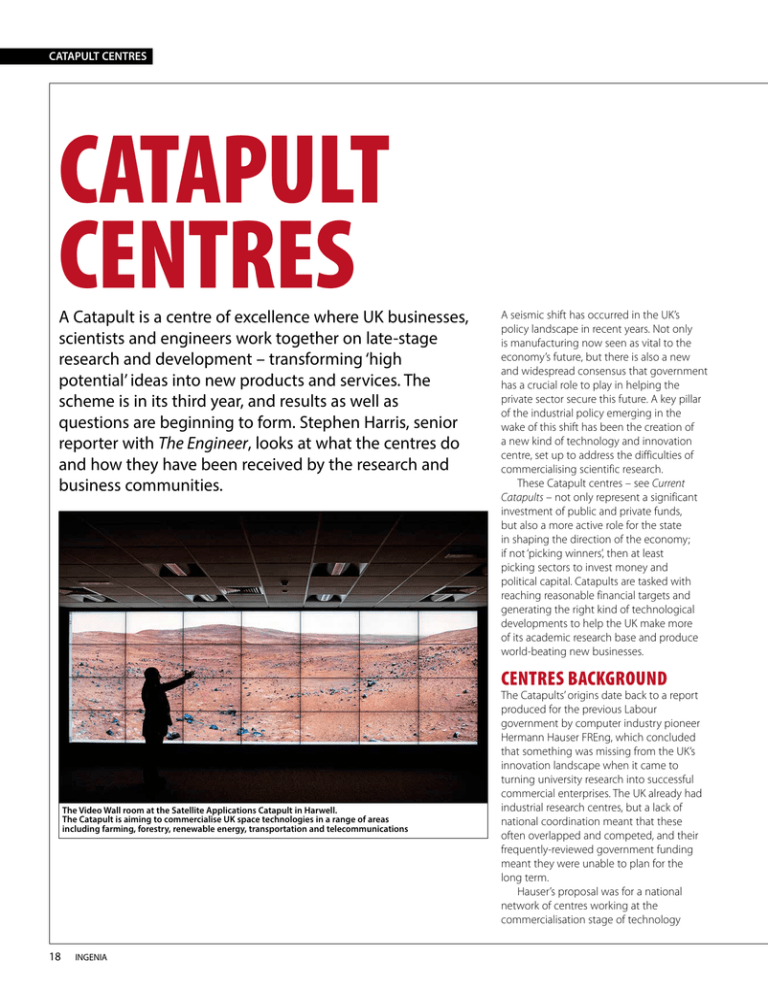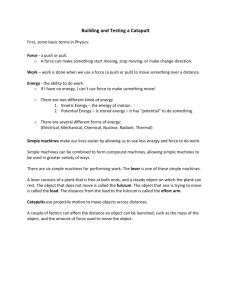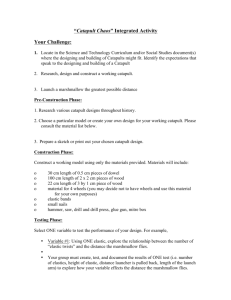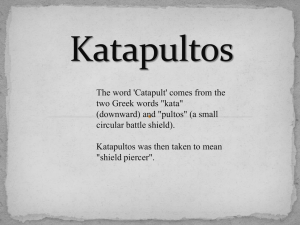CATAPULT CENTRES
advertisement

CATAPULT CENTRES CATAPULT CENTRES A Catapult is a centre of excellence where UK businesses, scientists and engineers work together on late-stage research and development – transforming ‘high potential’ ideas into new products and services. The scheme is in its third year, and results as well as questions are beginning to form. Stephen Harris, senior reporter with The Engineer, looks at what the centres do and how they have been received by the research and business communities. A seismic shift has occurred in the UK’s policy landscape in recent years. Not only is manufacturing now seen as vital to the economy’s future, but there is also a new and widespread consensus that government has a crucial role to play in helping the private sector secure this future. A key pillar of the industrial policy emerging in the wake of this shift has been the creation of a new kind of technology and innovation centre, set up to address the difficulties of commercialising scientific research. These Catapult centres – see Current Catapults – not only represent a significant investment of public and private funds, but also a more active role for the state in shaping the direction of the economy; if not ‘picking winners’, then at least picking sectors to invest money and political capital. Catapults are tasked with reaching reasonable financial targets and generating the right kind of technological developments to help the UK make more of its academic research base and produce world-beating new businesses. CENTRES BACKGROUND The Video Wall room at the Satellite Applications Catapult in Harwell. The Catapult is aiming to commercialise UK space technologies in a range of areas including farming, forestry, renewable energy, transportation and telecommunications 18 INGENIA The Catapults’ origins date back to a report produced for the previous Labour government by computer industry pioneer Hermann Hauser FREng, which concluded that something was missing from the UK’s innovation landscape when it came to turning university research into successful commercial enterprises. The UK already had industrial research centres, but a lack of national coordination meant that these often overlapped and competed, and their frequently-reviewed government funding meant they were unable to plan for the long term. Hauser’s proposal was for a national network of centres working at the commercialisation stage of technology INNOVATION CURRENT CATAPULTS Map showing the location of the seven Catapult centres 1 A C development, matching scientific research to industrial needs and providing the facilities and expertise to help shoulder risk until the private sector felt secure enough to invest more heavily. The central idea was to bring academics, small and medium‑sized enterprises (SMEs) and large firms together in centres of excellence, both to lead to successful new products and also build strong supply chains. The network would anchor industry in the UK with high-tech facilities and a research pipeline that would be difficult and expensive to replicate elsewhere. UK politicians and business leaders had long been impressed with Germany’s Fraunhofer institutes, which have been successfully carrying out a similar role for decades and are vital to the German economy. The incoming coalition government, drawing on similar conclusions from a report by James Dyson FREng, decided to retain the plans for such a network. There are now seven Catapults up and running following government approval of an additional two in the autumn of 2013. As Hauser himself notes, the real impact of the Catapult centres won’t be known for another decade or two. However, nearly four years into the programme, it is already possible to identify some successes – and some big challenges that the centres still face. HVM CATAPULT The first centre, the High Value Manufacturing (HVM) Catapult, started work in October 2011. It brought together seven existing technology and innovation centres. The HVM covers a range of technologies, from the National Composites Centre in Bristol to the Advanced Forming Research Centre in B D E F G 2 3 4 5 6 The Catapult programme includes seven technology and innovation centres that will receive £200 million of government funding over a five-year period, with a further two due to be up and running by 2015. The Catapult centres are: 1. Offshore Renewable Energy, Glasgow 4. Future Cities, London 2. Transport Systems, Milton Keynes 5. Connected Digital Economy, London 3. Satellite Applications, Harwell 6. Cell Therapy, London The centres comprising the seventh Catapult, High Value Manufacturing, are: A. Advanced Forming Research Centre, Strathclyde B. Advanced Manufacturing Research Centre, Rotherham C. Centre for Process Innovation, Wilton/Sedgefield D. Manufacturing Technology Centre, Ansty E. National Composites Centre, Bristol F. Nuclear Advanced Manufacturing Research Centre, Rotherham G. Warwick Manufacturing Group, Coventry Glasgow. Its long-term goal is to stimulate growth in the manufacturing sector and to more than double the sector’s contribution to the UK’s GDP by providing a gateway to the best manufacturing talent and facilities. Despite these centres coming with their own pre-established practices and structures, the HVM Catapult is the one most clearly fulfilling the initial targets of the programme. It provides facilities and equipment for companies to test ideas, develop processes and create technologies, shouldering the high costs that could be prohibitive even to large firms. It brings together academics, SMEs and big industrial players from across the UK to jointly address industrial technology issues with a commercial focus. In its first full year, the HVM Catapult worked with 571 partners on 830 projects. The Catapults aim to match their core government funding from the Technology Strategy Board (TSB) with equal amounts from private investment and competitive R&D grants so that each funding source provides a third of the total revenue. The first year saw the HVM Catapult raise 35% of its £134 million worth of activity from the private sector. The Catapult CEO, Dick Elsy, says that the industry’s support for the Catapults has been so strong that this figure is now 40%, while R&D grant revenue in the last six months is already double the figure raised during the entire first year. INGENIA ISSUE 58 MARCH 2014 19 CATAPULT CENTRES These centres are taking more of an active role within their respective industries and guiding the direction of research Unlike the rest of the Catapult network, HVM is formed from constituent independent and university‑based research centres that still function as separate entities within the Catapult structure and charge individual fees on a membership or project basis at a range of price points, bringing with them not only premium partners such as RollsRoyce, Boeing and Jaguar Land Rover but also a host of SMEs from across the country. This, together with the fact these centres were already up and running, helps explain the HVM Catapult’s success in generating so much private funding so quickly. An added advantage is that bringing them together under one umbrella organisation means that they are less likely to compete for the same work and can instead work collaboratively to provide a range of services to partner companies. The flexible fee structure means that firms are not limited to working on specific projects and through the membership system in particular, companies have scope to more generally share ideas and sometimes contribute in kind. Hewlett Packard, for example, provided hightechnology systems equipment to the Manufacturing Technology Centre in Coventry (one of the HVM Catapult constituent centres), worked with lead companies like Rolls‑Royce to develop solutions which were then introduced to a small firm to help it create an application for a previously shelved project. The HVM Catapult model, building on the work of the existing centres and their relationships with business, appears to be meeting a specific demand from industry. The other six Catapults now up and running are evolving and expanding the mission of the Catapult programme in different directions. WORLD-CLASS RESEARCH The clean room at the HVM Catapult Centre for Process Innovation (CPI) at Redcar. The CPI houses the UK’s National Printable Electronics prototyping centre and can develop both organic light-emitting diode (OLED) and organic photovoltaic (OPV) technologies. Companies can use its vacuum and conventional coating technologies applications, from research to pilot-scale production 20 INGENIA The sectors covered by the other Catapults were chosen as areas where the UK was deemed to have world-class research capabilities that would benefit from support through commercialisation but also had a large potential global market. They were chosen by the Technology Strategy Board which identified the sectors that either would benefit from well-funded facilities or where there was a clear gap between the requirements and opportunities of industry and the commercial technology that was emerging. Some of the chosen areas are well‑defined with an obvious role for an innovation centre, such as with the Offshore Renewable Energy and Cell Therapy Catapults. Others have a broader and sometimes more nebulous remit spreading across industrial sectors, for example those for Transport Systems and Connected Digital Economy – which focus on developing transport infrastructure INNOVATION and internet‑based software for a range of industries, respectively. These centres are taking more of an active role within their respective industries and guiding the direction of research. The point of all the Catapults is to encourage solution development. These Catapults are more proactive in helping to determine what problems need solving. While the HVM Catapult does this to an extent, it also carries out contract research and works with individual companies, whereas the other centres focus on putting together collaborative projects. The Cell Therapy Catapult, for example, is helping develop a number of university projects to the point where they can attract venture capitalists and other investors. At the same time it is matching the needs and expertise of large companies with smaller firms bringing new ideas they cannot commercialise on their own. It is also encouraging foreign investment by acting as a liaison for companies that have an interest in setting up facilities in the UK. The Catapult is working with range of organisations from GlaxoSmithKline to the much smaller Intercytex, which is developing a device for injecting cells into the skin. The more IT-focused Catapults, including the Satellite Applications and Future Cities centres –targeted on the use of satellite data and digital urban infrastructure, respectively – are aiming to guide the research agenda and communicate the needs of other industries and society to the technology community. This has included organising ‘hackathon’ events, where programmers from different organisations work together to tackle a problem or develop ideas in a specific field. The Satellite Applications Catapult ran a hackathon event that led to a development that uses satellite data to pinpoint jellyfish blooms which have the potential to disrupt nuclear power stations by attacking their water inlet systems. In addition, the Catapults are becoming hubs for networking and business development, providing advice and helping partners find investment. Some of the centres are even trying to take a broader industry leadership role: for example the Offshore Renewable Energy Catapult is bringing together companies more used to competing with each other to share best practice and develop industry standards. SHARING RESOURCES MTC’s CAVE virtual reality suite. A CAVE is a video theatre sited within a larger room. The walls of a CAVE are made up of flat panel displays and the visualisation system uses 3D simulation software to help researchers see inside a complex assembly. The user wears 3D glasses inside the CAVE to see the 3D graphics. People using the CAVE can see objects apparently floating in the air and walk around them, generating a view of what they would look like in reality The Manufacturing Technology Centre (MTC) is one of the seven centres that make up the HVM Catapult. One of the schemes that MTC helps run is the Centre for Advanced Simulation and Modelling (CASiM2). CASiM2 is a collaborative project with three partners: the University of Birmingham, MTC and Rolls-Royce. Part-funded by the European Regional Development Fund, it helps SMEs based in the West Midlands to share knowledge and expertise in manufacturing simulation and modelling. Assembled Electronic Solutions (AES) was one of the first SMEs (defined for this scheme as businesses that have fewer than 250 employees and turnover not more than €50 million) to see the commercial benefits of using the MTC’s CAVE virtual reality suite. AES designs and manufactures products for the automotive, medical and aerospace industries. In six years of trading, the Stratford-based electronics design and manufacturing firm had already developed a strong client portfolio which included ADI, Rolls-Royce, Moog and Goodrich. AES hoped that the CASiM2 project would allow access to simulation technology that would provide the breakthrough to proving the concept of a new industrial machine. The product was at CAD design stage and required physical production to test if the concept would work in real manufacturing environment. To move past this barrier, in October 2013, AES started to use MTC’s four-walled immersive environment to simulate advanced manufacturing processes in 3D and real time. The technology enabled itsengineers to test complex processes without time-consuming and expensive investment in hardware and plant. The project reduced the design and development process time and brought the new product to the market more quickly. This has secured a new long-term contract with a major company, enabled AES to expand its plans for the product and to look further afield at global expansion. INGENIA ISSUE 58 MARCH 2014 21 CATAPULT CENTRES The Catapults all face a number of key challenges in achieving their goals, the biggest being to build sufficient awareness and trust among the business community GAINING A FOOTHOLD It is still early days for these Catapult centres, many of which have been established in the last two years and most of which have yet to move into purpose-built facilities. However, the public reaction to the programme has been almost wholly positive. There is broad political consensus for the centres, even at a time of deep public spending cuts. And business leaders have been publicly full of praise, with particular support from some of the country’s most important manufacturers, such as Rolls-Royce. It is difficult to find someone within engineering who is against the principle of government funding for applied research. It is the case that big firms used to conduct much more of their own research without state support, but in those times there were more public organisations that had laboratories and workshops. This indicates The Cell Therapy Catapult was established by the Technology Strategy Board in 2012. The aim of this Catapult is to help UK to become a global leader in cell-based therapies and their development and commercialisation 22 INGENIA that government involvement in technology has always been vital to research. It is also the case that cutting-edge technology is now more expensive to push forward and it is easier for international companies to move their R&D operations to cheaper locations. Whether the Catapult programme’s model and choice of sectors is right, however, is debatable. It is relatively easy to see the need for government to fund costly advanced manufacturing facilities, labs for risky biotechnology experiments, or computer systems for processing large amounts of complex satellite data. However, it is harder to justify spending millions in areas where the private sector is already rather good at producing commercial technologies, for example in the digital sector, where barriers to entry are low and enterprises are constantly springing up to offer useful new products or tackle societal problems. There also appears to be significant overlap between the Connected Digital Economy, Future Cities and Transport Systems Catapults, as demonstrated by several co-run projects. There are, of course, areas where strategic planning is vital, where problems must be highlighted and solutions supported before the private sector will get into gear. The UK does not have an equal to Silicon Valley and the government probably has a role to play in fostering the digital business community. But that does not necessarily require an innovation centre along the same lines as that introduced for Offshore Renewable Energy. In effect, the Catapult brand has been applied to a widely divergent set of organisations, some of them with broad sector or even cross-sector remits, sharing a collaborative funding model and the general goal of supporting commercial technology development. Those who particularly admire the 60 German Fraunhofer institutes, which INNOVATION AMRC TESTING each focus uniformly on developing a specific technology area such as lasers or thin films, may see this as a mistake. SERVING INDUSTRY? There is also a danger that those Catapults seeking more of a leadership role may move away from the Fraunhofer-inspired aim of serving industry, into a position where public officials set the research goals, commissioning too many of their own projects instead of acting as a facilitator. It is argued that the this was the policy pursued by the Scottish Intermediate Technology Institutes in the first decade of this century, when £230 million was spent on three centres that were wound up after eight years. The HVM Catapult centres have given some indication of how this problem can be avoided, helped by their regional locations and their links to businesses through established university partnerships. The newer centres need similar partnerships to ensure that they are responding to genuine gaps in the market and not duplicating work already going on in other research centres. While Fraunhofer follows a similar three‑part funding model, its core government investment is matched to the amounts raised from the private sector, unlike the Catapults which receive a predetermined grant. Proponents of the Fraunhofer model argue that this forces the institutes to think in a more commercial way because there is no guaranteed income. However, a secure revenue stream does have its advantages, notably allowing long‑term planning. The Fraunhofer Society has been around since the early 1970s and has had plenty of time to establish a successful self-sustaining model. The HVM Catapult, with its pre-existing centres, has proven its ability to match core funding Turbine discs and blades are at the heart of every engine that Rolls‑Royce make and the conditions in which they must operate are some of the most extreme to be found in modern‑day power systems. Turbine blades are made using advanced ceramic moulds and precisely controlled furnaces, while discs are made by advanced powder processing, forging and machining techniques that guarantee high temperature capability at lowest weight. When Rolls-Royce launched the plans for their new high‑technology disc factory in Washington, near Sunderland, they targeted a five- to six-fold reduction in the number of machining operations for each disc, with a view to increasing production capacity and reducing costs in the new factory. In realising such an ambitious improvement target, the company drew upon expertise from the Advanced Manufacturing Research Centre (AMRC) in Rotherham – one of seven centres that make up the High Value Manufacturing Catapult. Engineers and researchers from both organisations worked together to develop class‑leading technology aimed at reducing machining time, minimising operator interventions and delivering competitive cost and quality for disc manufacture. Advanced Finite Element Modelling techniques were used to shape the fixture designs and machining strategies that were necessary for improvements to the process monitoring and control of machining operations. By coupling the AMRC’s state-of-the-art machining capability with their core expertise in machining dynamics, discs were machined using the most optimal surface speeds while avoiding any detrimental vibrational instabilities. The technical methods deployed through the project enabled a step‑change improvement in cutting tool performance and processing times, enabling achievement of the ambitious five- to six-fold reduction target in machining operations posted at the start of the project. The major efficiency savings developed through this unique research and development methodology were fully validated by the manufacture of full scale demonstrator components at the AMRC, which underpinned the commitment and launch of the new disc factory by Rolls-Royce in Washington. with private contracts. What is not yet clear is when or if the other Catapults that have been started from scratch will reach this goal, or even exactly what their private income stream will comprise. GAINING TRUST The Catapults all face a number of key challenges in achieving their goals, the biggest being to build sufficient awareness and trust among the business community, in particular SMEs, in order to secure private income and ensure they are tackling the right problems. On a basic level, they need to make the majority of UK technology firms aware of the programme and what it offers. More specific worries for SMEs include security of IP and the risks of staff being poached. Arguably, these are common to any collaborative research and the Catapults may provide legal safeguards to protect smaller firms from larger partners, INGENIA ISSUE 58 MARCH 2014 23 CATAPULT CENTRES The autoclave at the HVM Catapult National Composites Centre in Bristol. Used in the production of composite materials, the 90-tonne autoclave operates at 400°C and a pressure of 200 psi developing components up to 10m long but persuading companies of their role as a facilitator will be key. The HVM Catapult also has the issue of its membership fees, which it needs to ensure are not creating additional barriers to innovative companies. Another challenge is the ability to make a deep impact on the UK’s innovation landscape with relatively limited resources. The centres are to receive a total of £200 million from government for the first five years of the programme and are attempting to triple that with research income. By comparison, the total annual Fraunhofer research budget is €1.9 billion. With this in mind, the flexibility of the Catapult model – where methods and functions vary according to sector – has some advantages. Dr Hamid Mughal OBE FREng, Rolls-Royce Director of Global Manufacturing and one of the Catapults’ most vocal supporters, says the Fraunhofer model looks ideal but is just not affordable in the UK at present. Instead, he says, the UK has a leaner system that combines the Fraunhofer focus on specific manufacturing technologies through the various HVM Catapult centres, with the addition of sector-based institutes that can respond directly to the wider needs of industries and the economy. Given the context set by Dr Mughal, it is critical that the newer centres show they can carve a niche for themselves and win private sector support, to avoid the risk that 24 INGENIA they will become vague, centrally mandated solutions searching for problems to solve, separated from the concerns of business and reliant on government funding. They are making the right noises; now they need to follow through by ensuring they settle on a model that both generates self-sustaining income and balances worthy research ideas with commercial potential and the needs of industry. If they can do this, they may have found the winning formula. Stephen Harris talked to David Bott, formerly Director of Innovation Programmes, Technology Strategy Board; Maurice Cassidy, Technical Director, Barkley Plastics; Mark Claydon-Smith, Head of Manufacturing, EPSRC; Simon Edmonds, Catapults Programme Director, Technology Strategy Board; Dick Elsy, CEO, High Value Manufacturing Catapult; Stuart Martin, CEO, Satellite Applications Catapult; Dr David Hughes FREng, Managing Director, The Business Innovation Group; Tim Holt, Executive Director (now retired), Fraunhofer UK; Andrew Jamieson, CEO, Offshore Renewable Energy Catapult; Colin McGrory, Technical Director, Sandwell UK; Dr Hamid Mughal FREng, Director of Global Manufacturing, Rolls‑Royce; Will Sterling, Contributing Editor, The Manufacturer; Craig Stevens, Account Director, Hewlett Packard Enterprise Services and Keith Thompson, CEO, Cell Therapy Catapult





